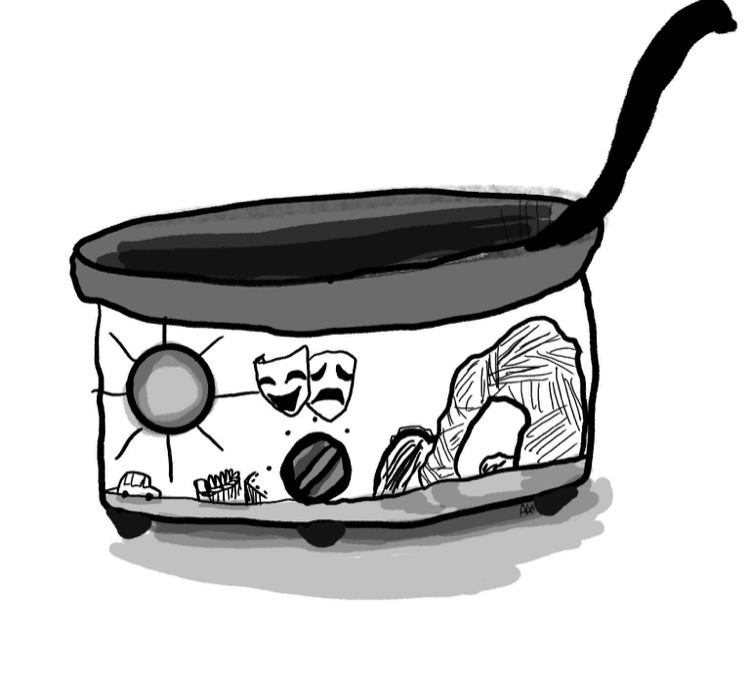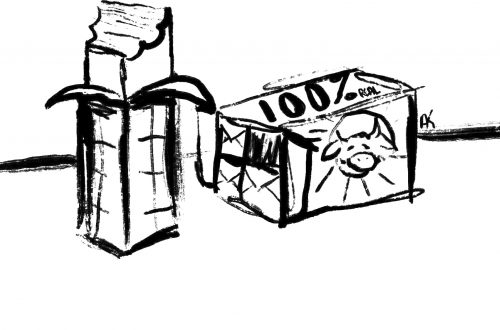by Laura Brennan
Laura’s essay appears in episode 41 of The Dirty Spoon Radio Hour.
I find myself in Utah at the start of 2022. I’m an actor in an eight-person educational touring production of Much Ado About Nothing. We also tour with a company manager, a stage manager, and a technician. I love this work. I have blossomed into a full-blown Shakespeare nerd in the past few years, and bringing Shakespeare to students is some of the most magical stuff there is. I’m addicted to this very specific thrill of seeing students’ eyes light up when they realize that they’re understanding Shakespeare. Something that previously seemed so elitist is comprehensible? And funny? And is being performed with lights, sound, props, costumes, and a full set in their school’s cafetorium at 9 a.m.? Please don’t misunderstand: many students nap through our shows. But for others, this is the first play they’ve ever seen! We perform for elementary through high school-aged students in Utah, Nevada, Arizona, Colorado, Wyoming, and Idaho. We go to some exceptionally rural communities. Lots of cows. Not a lot of theatre.
Our 11-person company consists of artists from all across the country, and we all arrive in Cedar City, Utah at the beginning of 2022 to start this Much Ado About Nothing contract. A few of my castmates are Chicago-based actors like me. A few are from New York. One brave soul on our tour drove from Texas. We’ve all descended on sunny Cedar City for the Utah Shakespeare Festival’s annual Shakespeare-in-the-Schools program.
Utah is like no place I’ve ever been. There are rusty red mountains everywhere. The expansiveness of everything spooks me a little. It is sunny in January. This also spooks me as someone who grew up with cloudy Pittsburgh winters, but the bright winter sunshine is welcome! Mormon culture is also more prevalent than I initially imagined. Impressive Latter-day Saint temples are easy to spot from the highway. They’re fortress-like, typically have bright white or cream-colored exterior walls, and each one is topped with a gleaming angel Moroni on a spire. At night the outside of the temples are aggressively illuminated so that from afar they look like a mass of twinkle lights against dark mountains and vast stretches of cattle fields. Alcohol and coffee are off-limits for Latter-day Saints, but sugar is fair game. As a result, the Utah liquor laws are rigid, and in lieu of 6% ABV beers in the grocery store, there are Crumbl cookie stores (originally founded in Utah) and soda shops galore. There is also a Fundamentalist Church of Jesus Christ of Latter Day Saints community in Cedar City, and I see women and young girls with impressively braided hairstyles and long, pastel dresses in the park near our apartments and at the local Walmart.
It’s common to travel to new places for work multiple times per year as a theatre practitioner. If you’re lucky (i.e. employed), you’re frequently packing your life into suitcases to spend a few weeks or months on a contract. It’s a unique way to see different parts of the country and to quickly make new friends. Like clockwork, I feel nervous airport butterflies whenever I’m about to start a new job, but this unsettled feeling always fades. The grand payoff is a new experience with new friends and a new piece of theatre that you get to make together. As a deeply introverted, self-professed country mouse, I value being shot out of a cannon into new experiences like this. Still, it’s difficult to spend months away from your friends, your family, and your own bed.
An educational tour is a uniquely specific type of contract. It entails rehearsing a show in one place for a few weeks, learning how to teach a theatre-based workshop for students, learning how to construct, deconstruct, and tetris-pack your set into a truck or van, and then literally taking the show on the road. You’ll typically stay in multiple different spots throughout the week based on which schools or venues have booked the show through the producing theater’s education department.
The work of an educational tour is hard but rewarding. The schedule changes constantly, and you quickly learn how to squeeze in a full REM cycle from the back seat of a minivan. One of my Much Ado castmates has an entire playlist series with the primary function of being so chaotic and shockingly varied in song genre that it can keep the driver alert and awake for hours. Some mornings on the Much Ado tour, we are in our vans at 4 a.m. to travel to a show. When we arrive at the school or venue, we groggily but carefully unload our set and lights and sound system and props and costumes from our 15-foot box truck. “Hands on. Hands off,” is our constant safety chorus as our box truck lift gently lowers enormous black trunks onto the loading dock and we steady them with multiple sets of hands. We roll or team-lift our stash of theatrical goodies into the new space and set everything up. Lights are focused, and sound is tested. We get into costume. My fellow castmates and I do some lip trills and planks as we vocally and physically warm up as efficiently as possible. We do our show. The company returns to the stage after our bows for a talkback with the audience: students can ask us questions about the show or about theatre in general. The questions range from incredibly insightful (“Why does Don John feel such vicious animosity towards his brother Don Pedro?”) to “what was that show about?” We do a workshop with students in which we gently beg them to wear their masks. We deconstruct our set and lights and sound system and props and costumes and strategically load it all back into our truck. We caravan our 15-foot box truck and two minivans back to our motel. We are exhausted but happy. I see those thrilling sparks in some of the students’ eyes. When they laugh with Benedick or jeer at Claudio, we know we’ve won their attention and, perhaps, their hearts. These invested and uninhibited student audiences are my favorite.
But we are so hungry. Reliable food sources are few and far between. We are staying mostly in budget-friendly hotels and motels as we tour through the west. Except for one luxurious Airbnb stay in a giant house full of BYU paraphernalia, we have no access to a kitchen. We find dinners and snacks where we can, but sometimes the only thing open when we drive into town is the local gas station supermarket. If we’re staying in or around a larger city, we make a sacred pilgrimage to Whole Foods or Trader Joe’s to strategically stock up on groceries that we can squeeze into our motel mini fridges. A few of us develop an expensive, low-grade addiction to green juices for the sake of convenient nutrients. I quickly learn the value of having a mini fridge and microwave in the room. In addition to my luggage, I take to toting around Trader Joe’s bags full of produce and other snacks. I’ve played fast and loose with transporting my greek yogurt and half and half from motel mini fridge to mini fridge.
And then in early March, we travel to Delta, a small town in central Utah. This booking is a little unusual because we’ll have an evening show open to the whole community instead of our typical school-day show for students. Today’s schedule looks like this: we’ll do a workshop in the afternoon for theatre students, we’ll load our set into the auditorium, we’ll check in to our Days Inn, and finally we’ll have an evening performance open to students and the community. The performance is sponsored by the county’s cultural council. They will be providing us with a dinner at the high school before our evening performance. Naturally we are thrilled! We’ve been subsisting on microwave fare for weeks. It’s a bright and sunny Utah day, the school is beautiful, and the auditorium is enormous. The dressing rooms are spacious and clean, and the workshop students are earnest and delightful. We are characteristically hungry though, so everyone is looking forward to this cultural council dinner. Provided meals on tour, however, can be a real mixed bag. We’ve been burned before in the style of room-temperature pizza from the school cafeteria. We temper our hopefulness for a warm and nourishing pre-show meal.
But when we arrive back at the high school for this dinner, we are greeted by a spread of crockpots and insulated stock pots accompanied by the home cooks themselves. There is no leftover cafeteria lunch fare here! We deduce that these sweet and smiling home cooks are mostly Mormon women (based on the fact that we are in central Utah and that we say a prayer before we feast). We secretly and lovingly crown them our Mormon mothers. Their hospitality will soon become tour legend. This early evening supper marks the beginning of what will be referred to as “Soup Show” for the duration of our tour.
There are seven or eight steaming containers of soups and chilis, a daring theme for a potluck. How will the soups stay warm? How do you prevent soup from sloshing all over the floor of your car in transport? Feels risky. But it’s exactly what we weary travelers need. Something warm and prepared in a real kitchen. There is chicken soup, vegetable minestrone, a meaty chili, a vegetable chili, potato and leek soup, etc. Truly a soup for every mood. Everything is labeled, and I want to sample all of it. Every topping you could ask for accompanies this extensive soup spread. There are also fresh veggies and fruits and breads and homemade individual dessert parfaits. We are giddy. We are overcome by this abundance and by the generosity of the cultural council women. Someone’s entire house must smell like cabbage right now so that we could be warmed by some delicious stuffed cabbage soup. We can’t stop thanking these women for the home-cooked food. We help ourselves to soup tastings. I have an empty mason jar in my backpack, and I store some extra veggie minestrone for a post-show treat. It’s a job for my motel microwave later, but for now the soups are steaming, our bellies are full, and we feel nourished and comforted. One of my castmates accidentally professes his love for one of our Mormon mothers. He is embarrassed, but I think the core sentiment is true. We are all deeply touched by the hospitality of these women. Who knew a soup buffet/potluck is exactly what this hungry touring company needed? Now we are fueled and ready to give this Utah community the best 75-minute educational production of Much Ado About Nothing they have ever seen.
In the women’s dressing room before the show, my castmate takes a video. In the video, the three other women in the cast and I are in costume and finishing our makeup right before we are called to places. We’re dancing and blasting Chance The Rapper’s “All Night” as we get ready for our show. We are sparkling and full of energy. We have truly been revived by soup! It’s one of my favorite videos. It reminds me how far a little homemade soup can go.
Original artwork by Alex Knighten
About the Author
Author bio forthcoming






